A pleasant and heartfelt account of one man’s brief journey into and out of education, Let That Be a Lesson left me feeling sad that our profession is failing to hang on to teachers like Wilson. By his own account in this book, he was frantic to enter the profession from childhood, yet he rocketed through the ranks and out the other side in a frenzied haze of marking and accountability.
From teachers behaving badly to students’ frankly mind-boggling misconceptions, Wilson’s memoir is unquestionably funny. In fact, it’s worth reading just for his hilarious anecdote about inadvertently cupping the headteacher’s wife’s breast. But while that’s a pretty unique situation to end up in (I assume), there is much that will be familiar to anyone who has worked in their local comprehensive. From inadequate training through to achieving local celebrity status, Wilson’s observational humour takes in the gold bullion-equivalent value of glue-sticks, agonising ‘wellbeing’ sessions, speed dating-style parents’ evenings, wasps in the classroom and a kid making you an offer you (almost) can’t refuse of some knock-off DVDs.
Yet for all that there is personal pain in Wilson’s journey. The loss of a much-respected colleague and very close friend to cancer clearly had a profound effect on his feelings about the job, and perhaps his conviction that life is too short to spend it strapped to a desk laden with exercise books.
Wilson also charts his own personal coming-out story. But that comes through as something of a gift in terms of his experience in education. He explains how he found inspiration in the openness of some of the youngsters he met and how this gave him the confidence to embrace his own sexuality.
Wilson does not attribute any of his growing disenchantment with the profession to the students; yet he does catalogue plenty of poor behaviour – what he refers to as “fights, bullying and general thuggery”. In my opinion, that our system somehow persuades someone like Wilson that putting up with this as an inevitable part of the job is an indictment. His positivity about young people is laudable, but would we still count him in our ranks if he’d been trained – and supported – to take a different approach?
Wilson’s journey is also a salutary lesson about early promotion. He seems at every point in his career to have been put under too much pressure, and not simply from excessive workload or accountability. During his first weeks in training, he was left unsupervised with difficult classes; he was asked to teach texts he hadn’t had time to read, let alone study; just five years later, he was in charge of a department of 18 people in an unfamiliar setting as head of English in an inner-city school. Beyond that lay senior leadership. Each moment in his career left me with the feeling that in the long-term this was never going to work.
Although the book reads like a series of anecdotes, divided into chapters with headings rather than numbers, there is a story arc here, and it is Wilson’s own alarmingly rapid trajectory from idealistic newbie to jaded senior leader. He explores some frankly corrosive thinking, culminating in a thoroughly depressing conversation with another senior leader who agreed that the school should hold a minute’s silence for the victims of a terrorist attack on the grounds that “Ofsted like that kind of thing”.
Wilson’s anger is palpable. And to an extent it’s rightly political, too. But ultimately the politicisation of his message is something of a disappointment. His stance that ‘The Two Michaels’, Gove and Wilshaw, have wreaked untold havoc upon our education system is simplistic to the point of naivety. It dates the book, and left me feeling somewhat dejected. The notion that those dastardly villains, the Tories, were behind it all along feels like a Scooby Doo-level analysis for what is otherwise a poignant and very personal account.
Surely a more useful lesson could have been drawn – for us and for Wilson alike.

This post was originally published in Schools Week magazine.





